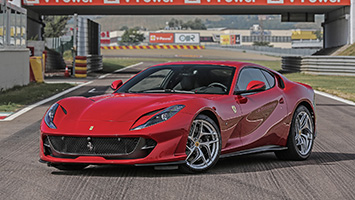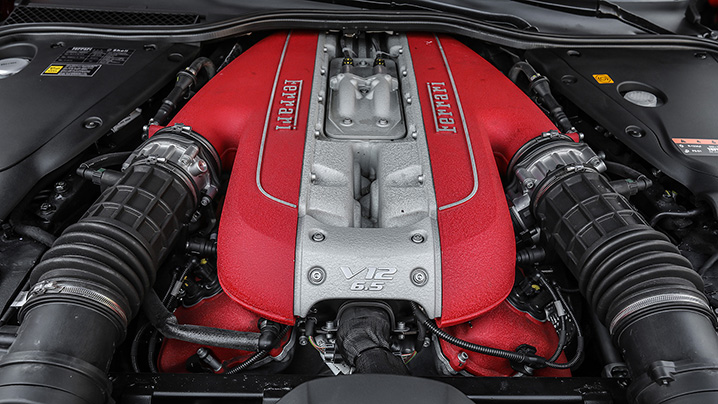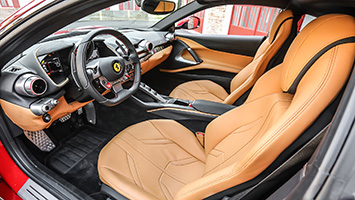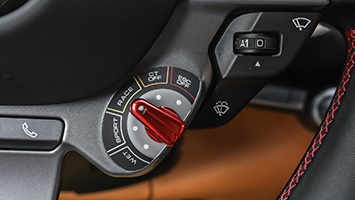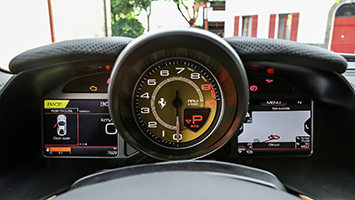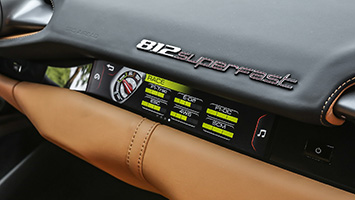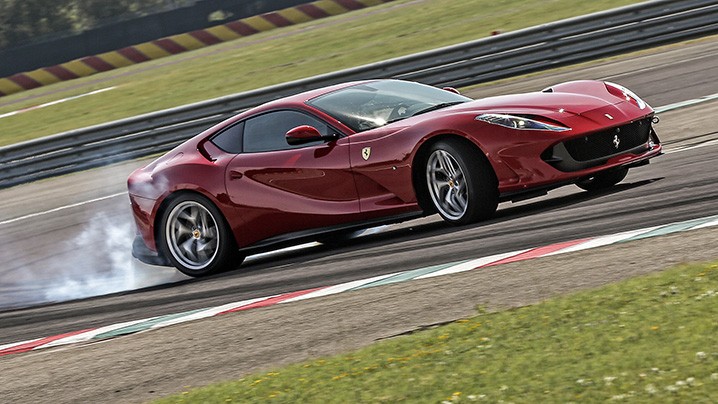Ferrari 812 Competizione and 812 Competizione A
From the official press release by the Ferrari Press Office: The 812 Competizione, the new limited-edition special series car derived from the 812 Superfast, was presented today to media, clients and fans all over the world. In the course of the event, which was broadcast live on Ferrari’s social media channels, the wraps were also whipped off the 812 Competizione A, a spectacular Targa-top version, again a limited-series and an homage to the Prancing Horse’s glorious open-top tradition.
The presentation took place in a very special venue, the recently-opened GT Sporting Activities Department located alongside the Fiorano track, further strengthening the inextricable link between Maranello’s road-going sports cars and the peerless racing DNA developed as a result of over seven decades of success on the world’s circuits.
The launch began with the 812 Competizione completing several laps of the circuit to give viewers a full appreciation of the car’s forms in this dynamic and high performance context in addition, of course, to hear the unmistakeable sound of Ferrari’s iconic naturally-aspirated V12. After the hot laps Enrico Galliera, Ferrari’s Chief Marketing & Commercial Officer, officially presented the car and then unveiled the 812 Competizione A.
This duo of cars is dedicated to a very exclusive group of collectors and enthusiasts of the most noble of Ferrari traditions, which focuses on uncompromising maximum performance. The innovative technological concepts applied to the engine, vehicle dynamics and aerodynamics have raised the bar to new heights.
Once behind the wheel of the 812 Competizione and the 812 Competizione A, the driver becomes one with the car, regardless of whether it is on road or track. The car guarantees instantaneous responsiveness to commands and absolute control even in the most complex of manoeuvres. Maximum fun behind the wheel and driving exhilaration are ensured at all speeds, thanks in great part to the new independent, four-wheel steering, which delivers exceptional agility and precision in cornering.
POWERTRAIN
The 812 Competizione and 812 Competizione A sport the most exhilarating V12 on the automotive scene and is derived from the multi-award-winning engine powering the 812 Superfast. The result is a naturally-aspirated 830 cv engine that pairs impressive power with electrifying delivery and the inimitable soundtrack that Ferrari V12 purists know well. To boost the output of the engine, which has the same 6.5-litre displacement as the 812 Superfast’s V12, several areas have been significantly re-engineered to achieve a new record red line while optimising the fluid-dynamics of the intake system and combustion, and reducing internal friction.
Maximum revs are now 9,500 rpm which, together with a rising crescendo of torque delivery, unleashes a feeling of progressive and boundless power and acceleration. A result delivered by the meticulous redesign of key engine components such as the con-rods, pistons, crankshaft and distribution. The titanium con-rods are 40% lighter than steel versions whilst delivering the same mechanical resistance; the piston pins, on the other hand, have been given a diamond-like carbon (DLC) coating to reduce the coefficient of friction to the benefit of performance, fuel consumption and wear. These modifications are combined with a rebalanced crankshaft, which is also 3 percent lighter than the previous version.
The most significant improvements, however, are to the distribution and the cylinder heads, which have both been completely redesigned. The cams (which now feature DLC coating) now action the valve stems via DLC-coated steel sliding finger followers, which are derived from Ferrari’s F1 experience and were developed specifically for this engine to provide a higher lift profile.
To ensure that the engine breathes correctly across the entire rev range, the intake system was redesigned: both manifold and plenum are now more compact to reduce the overall length of the tracts, thus delivering more power at high revs, while the torque curve is optimised at all engine speeds by a system of variable geometry inlet tracts. This enables the length of the intake tract assembly to be continuously modified, adapting it to the firing order to maximise the dynamic charge in the cylinder. The result is an engine that revs with tremendous speed all the way to the cut off with no drop off towards the red line.
To reduce friction and mechanical losses, thereby improving the engine’s overall efficiency, the engineers developed a new variable-displacement oil pump that continuously adjusts oil pressure across the engine’s entire operating range. Another important point to underscore is the adoption of a less viscous oil (Shell Helix 5W40) than used on previous V12s and the improvement in the flow rate throughout the entire oil scavenge line.
The direct fuel injection management strategy has been further developed to keep abreast with increasingly stringent emissions regulations. The calibration of the timing and amount of fuel injected, as well as an increase in injection pressure, have reduced emissions and the generation of particulate, especially when the engine is cold.
The ignition system is constantly monitored by the ECU which has an ion-sensing system that measures ionising currents to control ignition timing: it has a single and a multi-spark function to the benefit of smooth, flexible torque delivery. The ECU also controls combustion in the chamber to ensure that the engine is always working at peak thermodynamic efficiency, something also achieved in part by a sophisticated strategy that recognises the octane rating of the fuel being used.
To maintain the traditional incredibly high standard of engine sound to which Ferrari V12 owners are accustomed, whilst simultaneously introducing a GPF (Gasoline Particulate Filter) to the exhaust system that ensures compliance with the very latest emissions regulations, the engineers added a new exhaust tailpipe. This unusual and innovative design solution reinstates the medium-high frequency sound muffled by the use of the GPF.
In order to deliver excellent acoustics, performance and aesthetics, the exhaust tailpipes are visible to underscore their function and the car’s track-inspired character without impinging on the signature elegance of all Ferraris. Work was also carried out on the intake tract to which a second pair of resonators was added to enhance specific frequencies and the engine’s more noble combustion order harmonics, creating the perfect melding of the sound from the exhaust and from the intake system.
Both the 812 Competizione and 812 Competizione A are equipped with a seven-speed dual-clutch gearbox, pushing the performance of the latter to new extremes and delivering a new gearshift feeling for the V12. Calibration of the control strategies has reduced shift times by a further 5 percent. Although it retains the same gear ratios as the 812 Superfast, the new car’s changes are even more sporty, thanks to the extra 500 rpm in maximum revs allowed by the new V12.
Hand-in-hand with the performance boost comes further fine-tuning of the cars’ respect of emissions norms with an evolution of the HELE system, which enables an on-the-move Start&Stop function, and a series of emissions-reducing engine maps, which maintain the signature Ferrari V12 sound even at low speeds. When the HELE is deactivated, performance driving-oriented maps return with lightning fast gear-shifting for maximum response.
The cooling system has also been adapted to cope with the additional heat generated by the new engine’s extra 30 cv, resulting in the introduction for the very first time on a Ferrari V12 of a single front air intake that maximises the amount air of cooling air channelled towards the radiators. The entire coolant circuit has also been improved, increasing cooling efficiency by 10 percent compared to the 812 Superfast. In addition, the single air intake has been further optimised to improve the fluid dynamics of the engine intake manifold, thereby minimising charge losses along the tract.
Lastly, the engine oil tank was redesigned to cope with the extra flow (up by 30 percent) and to cope with the car’s greater lateral and longitudinal acceleration. Thanks to the optimisation of the interior chambers and volumes, the new tank saves over one kilo of oil compared to the 812 Superfast, making the 812 Competizione and the 812 Competizione A the cars that require the least oil in the current V12 range. In the final analysis, this also contributes to the overall reduction in the car’s kerb weight.
AERODYNAMICS
The increase in both the 812 Competizione’s engine output and maximum revs have resulted in a consequent increase in the heat to be dissipated. To meet these new demands, the efficiency of the cooling flow management has been improved without increasing the dimensions and weight of the radiating masses.
While on the 812 Superfast, the engine air intakes are set either side of the large central grille, the 812 Competizione adopts an integrated solution with a single air duct. This allowed the intake for the engine radiators to be extended sideways as far as the chassis allowed as well as reducing not just weight, but also losses to the intake plenum and thus the combustion chamber, which in turn, improved the overall performance.
The evacuation of the hot air coming off the radiator was improved by exploiting both the vents on the bonnet either side of the central ‘blade’, and the louvers in the wings. These areas are particularly efficient in terms of cooling and so allowed the designers to optimise and reduce the apertures on the underbody, all to the benefit of the efficiency of the front aero. All of this translates into 10 percent more efficient cooling of the engine fluids than in the 812 Superfast.
The shape of the engine vents either side of the bonnet’s blade is designed to guarantee correct management of the flows even when the 812 Competizione A is being driven in the open configuration: the hot air flow lines are deviated away from the cockpit and are channelled along the flanks until they eventually merge with the car’s wake.
The fact that the car is faster into corners demanded an improvement in braking power. Brake cooling is fundamental to avoiding compromising on either downforce generation at the front of the car or on the weight of the brakes themselves. Compared to the 812 Superfast, the brake cooling concept was completely redesigned around the new front “Aero” calliper which debuted on the SF90 Stradale and which has an air intake integrated into its casting.
Ventilation of the callipers and the pads is achieved by channelling the cool air captured by the generous opening on the side of the bumper towards the integrated air intake which then distributes the air flow inside the component. Naturally, the solution is only as good as the route the flow follows to get to the calliper area at the rear of the wheel assembly: for this reason the front suspension was optimised around the hub and the layout of pipes and ancillaries in that area.
Thanks to these modifications, the temperature of the brake oil has seen a significant reduction: compared to the brakes on the 812 Superfast, operating temperatures have been reduced by around 30° C, thus guaranteeing consistent braking and equally consistent pedal feel even under prolonged track use. The removal of the 812 Superfast’s turning vanes and specific duct shaved a further 1.8 kg off the car’s weight, thus compensating for the additional weight of the “Aero” calliper.
Two carbon-fibre side air intakes for the brakes flank the main grille, which feeds cooling air to the engine and cockpit. These intakes are square in section and are split between brake cooling and a double air curtain duct. Thanks to the latter, the charged flow that strikes the side of the bumper is channelled and used to reduce the turbulence generated by the outer part of the tyre tread, thereby improving the front downforce generated by the outside edge of the bumpers.
Externally the front air intakes are hugged by the scooped side area of the bumper, which extends forwards along its lower edge, defining the shape of the splitter. Two apertures in the wheelarch, one at the top and one at the rear, reduce pressure and enable the underbody to work even more efficiently. The turbulence is channelled and evacuated by the vent rear of the bonnet’s blade, and by that on the wing.
Optimising thermal flows was a fundamental part of developing the 812 Competizione’s front underbody. In fact, the louvres on the bonnet and vents on the front wing meant the size of the vents in the front underbody designed to dissipate hot air coming off the radiators, could be reduced. This translated into a smaller area of the underbody being affected by apertures that would negatively impact downforce generation. The end result was a higher level of downforce at the front and a more energised flow striking the rear of the car.
The modifications made to the braking system also enabled the engineers to redesign the front underbody to extend it into the wheelarch well. The new layout, which freed up space around the lower front wishbone, made it possible to extend the surface area that could be used to generate downforce. It also allowed the insertion of a new S-shaped side vortex generator crafted specifically in the wind tunnel to improve the lateral expansion of the vortex generated and ensure it works in synergy with the front diffuser. The geometry of the latter was also optimised and can now generate even more downforce than the 812 Superfast as well as improving cooling of the calliper. Taken together these solutions hail a significant improvement in performance: optimising the air vents contributes to a 30 percent increase in overall front downforce while the new side vortex generator adds a further 40 percent.
Like on the 812 Superfast, the front diffuser is equipped with a passive mobile aero system which opens over 250 km/h. When the panel rotates it completely stalls the diffuser allowing the car to reach its maximum speed.
The 812 Competizione’s distinctive tail-end treatment incorporates a number of innovative engineering solutions regarding the exhaust layout, diffuser geometry, spoiler volume, patented rear screen and the bumper design. The rear diffuser extends right across the full width of the car to guarantee maximum horizontal expansion of the underbody’s aerodynamic flows and hails a distinct break with the solution seen on the 812 Superfast.
The silencers and tailpipes have been completely re-engineered: from a classic set up of two circular tailpipes each side of the bumper there is now a single exhaust pipe with an unprecedented vertical rectangular form. This had two positive impacts: it maximised the volume dedicated to the rear diffuser’s expansion and opened up the possibility of introducing a solution typical of F1 cars from the 2010s to a road car – dynamic interaction between the exhaust gases and the diffuser’s field. In this configuration, the hot flow of gas from the exhaust pipes interacts with the prominent curved exterior fences on the diffuser, generating extra vorticity at the trailing edge of the fences, which energises the “cold” flow from the diffuser thereby guaranteeing additional downforce.
Overall, the rear diffuser development produced an increase in downforce that equates to 25 percent of the total increase compared to the 812 Superfast. This jumps to 35 percent if the contribution of the exhausts blowing into the wake is also taken into account. The rear underbody, on the other hand, is responsible for a 10 percent increase in rear downforce.
The aerodynamic development of the diffuser forms allowed the areas of the car dedicated to downforce generation to be extended transversely. The spoiler is now not only higher than on the 812 Superfast, but extends across almost the entire width of the car, working in perfect aerodynamic synergy with the diffuser to guarantee maximum downforce possible over the rear axle. The redesign of the rear wings also benefits aerodynamic performance: the volume has been scooped out rear of the crest to create an aerodynamic channel in the flank to the outside edge of the spoiler which is thus struck by a highly energised flow.
But what really captures the attention is the rear screen which, for the first time on a production car, is completely closed and thus allowed the engineers to explore some unprecedented aerodynamic solutions. It has been equipped with three pairs of profiled elements which protrude from its surface and act as vortex generators. From the LaFerrari onwards, vortex generators of this type have been used on production cars to maximise downforce generated by the flat underbody. However, this solution was applied to the rear screen on the 812 Competizione to distort the flow and thus redistribute the rear axle’s pressure field.
These vortex generators further enhance the work of the rear spoiler-diffuser system, creating areas of strong pressure gradients in the flow immediately above the rear screen and generating vortexes on the transverse plane. Thanks to this solution, part of the flow is deflected towards the sides of the spoiler which boosts downforce generation, benefiting the efficiency of the diffuser. The patented vortex generators alone guarantee 10 percent of the total increase in rear downforce compared to the 812 Superfast.
The three horizontal slots on the side of the rear bumper just behind the rear wheel are another visually striking novelty. In addition to recalling the F12tdf, they also hide a system of three aerodynamic flicks. Due to the low-pressure area created by the car’s wake, part of the flow downstream of the rear wheel naturally tends to be drawn towards the centre of the car. However, with this new solution, it enters the bumper through the three horizontal slots and is then deflected upwards by the internal flicks, contributing to rear downforce.
In the 812 Competizione A, to compensate for the impact of the removal of the vortex generators, a bridge element has been introduced between the flying buttresses. Thanks to meticulous optimisation, the flow is deflected effectively and efficiently towards the rear spoiler, essentially restoring the downforce to the same level as the 812 Competizione. The presence of the bridge allowed the increase in physiological drag for a Targa type car to be reduced: aerodynamically, the bridge behaves like a wing so the pressure on the upper surface creates a positive pressure field which increases the speed of the flow downstream of the rear screen and reduces drag.
Occupant comfort in the open configuration is ensured by the introduction of a flap integrated into the windscreen header rail which deflects the energised, incident flow upwards avoiding that it disturbs the interior. This extends the bubble that covers the entire length of the cockpit, thereby also avoiding irritating excess pressure in the area behind the occupants’ heads.
Two aerodynamic apertures have been created between the two buttresses to manage the flow entering over the side windows and to force it to follow a specific route, a fundamental factor in reducing both pressure inside the cabin and the instability of the flow itself. The result of this strategy is twofold because, aside from improving comfort, it also increases aerodynamic efficiency by making the flow stable even when the top is open.
VEHICLE DYNAMICS
The guidelines in the development of the 812 Competizione’s performance strategy were to boost overall performance levels, improve driving pleasure in lateral dynamics and a specific focus on the handling characteristics of a special version.
The 812 Competizione debuts many innovative components and contents, which have ensured it delivers on its vehicle dynamics performance targets. Specifically, these include the first use of independent four-wheel steering, the evolution of the Side Slip Control (SSC) system to version 7.0, and the development of the dedicated new Michelin Cup2R tyres.
The independent rear-wheel steering features a new electronic management system that enables the right and left actuators to be actioned individually rather than synchronised. This evolution yields a significant boost in performance in relation to the control of the position demanded of the individual actuators, and quicker response times.
This system emphasises the front axle’s response to steering wheel commands, maintaining the feeling of grip from the rear axle, which responds promptly to front inputs, and also manages the car’s lateral dynamics response more efficiently as a function of the actuation frequency of the steering wheel angle.
The new solution has resulted in the evolution of the SSC system which brings together all of the control systems developed in-house and uses a shared dynamic control language to integrate the actions of all of the systems to improve efficiency. The Side Slip Control 7.0 spans the electronic differential (E-Diff 3.0), traction control (F1-Trac), SCM-Frs magnetorheological suspension control, brake pressure control when driving on the limit (FDE) available in Race and CT-Off Manettino settings, and the Virtual Short Wheelbase 3.0 which integrates the electric front steering with the electronically controlled independent rear-wheel steering.
Particular attention was also paid to making the car as light as possible, which resulted in 38 kg being slashed off its overall weight compared to the 812 Superfast. The areas primarily involved were the powertrain, running gear and bodyshell. Carbon-fibre was used extensively on the exterior, especially on the front bumpers, rear bumpers, rear spoiler and air intakes.
The powertrain contributions to weight reduction came from the use of titanium con-rods coupled with a lighter crankshaft and a 12V lithium-ion battery. Great attention was also paid to the design of the cockpit with the extensive use of carbon-fibre trim, lightweight technical fabrics and a reduction in sound-proofing. There are also dedicated sporty, lightweight forged aluminium rims and titanium studs.
All-carbon-fibre rims are also being made available for the very first time on a Ferrari V12 and offer a total weight reduction of 3.7 kg compared to the lightweight forged 812 Superfast wheels. The inside of the channel and of the spokes is coated in a layer of white aerospace-derived paint that reflects and dissipates heat produced by the car’s extremely efficient braking system, guaranteeing consistent performance over time even under hard use on the track.
STYLING
EXTERIOR
The 812 Competizione has a personality all of its own that sets it very clearly apart from the 812 Superfast in terms of its proportions and formal balance. The engineering modifications adopted allowed the Ferrari Styling Centre to give the car a whole new connotation, by choosing styling themes that further enhance its architectural design, sculptural forms and sporty vocation.
One of the 812 Competizione’s many striking features is its bonnet, which has a transverse groove in which the carbon-fibre blade sits. This proved an original way of disguising the air vents for the engine bay, whilst also increasing their surface area. From a design perspective, the choice of this transverse element rather than the louvres seen on some previous Ferrari sports cars, means that the bonnet looks cleaner and more sculptural. This theme also acts as a three-dimensional interpretation of the concept of livery, recalling the signature stripe across the bonnet that characterises certain historic racing Ferraris.
The modified front-end aerodynamics allowed the designers to endow the car with a more aggressive character befitting its limited-edition special status. The car’s nose shows off all of its imposing power with a very wide front grille flanked by the two distinctive and prominent side brake intakes. The carbon-fibre splitter underscores the car’s broad, squat stance, hinting at its impressive road-holding.
The most noticeable aspect of the 812 Competizione’s aesthetic is the replacement of the rear screen by an all-aluminium surface. The vortex generators on the upper surface that boost the car’s aerodynamic efficiency simultaneously create a backbone effect that underscores the car’s sculptural forms. Together with the carbon-fibre blade that traverses the bonnet, this motif changes the overall perception of the car’s volume: the car seems more compact than the 812 Superfast, accentuating its powerful, fastback look. Not having a rear screen also creates a textural continuity between roof and spoiler, providing owners with the opportunity to personalise the car even more with a whole new single continuous graphic livery that runs unbroken its entire length.
Even the rear spoiler now looks more imposing. It is higher but the specific design treatment used also makes the tail look very wide, almost horizontal, giving the rear greater stance. The extremities of this aerodynamic appendage intersect with the line of the rear wings, highlighting their muscular appearance and referencing iconic cars like the Ferrari 330 P3/P4. The bodywork rear of the crests is fluted and this accentuates the three-dimensionality and distinctiveness of the car’s flanks and their forms.
The taillight clusters lend the car a more aggressive and suggestive look. They fit seamlessly into a slit just below the spoiler and contribute to creating the horizontal feel to the rear. The rear bumper is particularly sculptural and characterised by a scoop at wheel height that incorporates two imposing air vents. Three aerodynamic slots have been created along the outer bumper surface rear of the wheels, creating an instantly recognisable styling feature that recalls the shape of the vortex generators on the rear screen.
COCKPIT
In terms of its interior architecture, the 812 Competizione has remained faithful to the 812 Superfast, retaining the same general parameters and main dash and door panel interfaces, including the latter’s signature “diapason” motif. The door panel itself has been lightened overall both formally and in terms of actual weight to underscore the sportiness of the cockpit.
The door panel pocket juts out from the main structure almost as if it were a floating element. This creates a sense of lightness and formal and textural continuity with the rest of the cabin. Only a small appendage that connects to the door handle remains as an armrest, but creates a dynamic muscle on the panel.
Right in the central area of the cockpit is a link between Ferrari’s past and future, the iconic gear-gate theme here given a modern twist. This is the first time it has appeared on a V12 car and is very much mirrors the spirit of the 812 Competizione and the marque’s tradition.
812 Competizione A
The 812 Competizione A provided the Ferrari Styling Centre with the opportunity to use the modifications required for the rear of the car to create a truly unforgettable architecture. The flying buttress concept, which has long been a much-loved part of Ferrari tradition, harmonises effortlessly with the arrow theme of the front created by the blade and lends a sense of forward thrust to the car’s body, but also gives it a completely different connotation to the coupé.
The car’s centre of gravity appears lower, particularly when seen from the side, not only because of the roof and wraparound windscreen that flows into the side windows, but also because the flying buttresses at the rear are lower than in the 812 Competizione. With the Targa top stowed, the roll bars partly jut out above the rest of the bodywork but because they are carbon-fibre, they become secondary visual elements and so do not compromise the broader, more squat stance created by the flying buttresses. This amplifies the visual lowering of the side view.
In the closed configuration, the roll bars connect perfectly with the roof structure forming a seamless unit. The targa top is made from carbon-fibre to create a sense of aesthetic continuity with the roll-bars. In the open-top configuration, it is stowed in a compartment with the same design shape as the targa itself. Being able to stow the top at any time means the car can be enjoyed to the full, whatever the weather.
7 YEARS MAINTENANCE
Ferrari’s unparalleled quality standards and increasing focus on client service underpin the extended seven-year maintenance programme offered with the 812 Competizione and the 812 Competizione A. Available across the entire range, it covers all regular maintenance for the first seven years of the car’s life. This scheduled maintenance programme is an exclusive service that allows clients the certainty that their car is being kept at peak performance and safety over the years. This very special service is also available to owners of pre-owned Ferraris.
Regular maintenance (at intervals of either 20,000 km or once a year with no mileage restrictions), original spares and meticulous checks by staff trained directly at the Ferrari Training Centre in Maranello using the most modern diagnostic tools are just some of the advantages of the Genuine Maintenance Programme. The service is available on all markets worldwide and from all Dealerships on the Official Dealership Network.
The Genuine Maintenance programme further extends the range of after-sales services offered by Ferrari to satisfy clients wishing to preserve the performance and excellence that are the signatures of all cars built in Maranello.
812 Competizione* – TECHNICAL SPECIFICATIONS
ENGINE
| Type | V12 – 65° |
| Overall displacement | 6496 cc |
| Bore and stroke | 94 mm x 78 mm |
| Max. power output** | 610 kW (830 cv) at 9,250 rpm |
| Max. torque** | 692 Nm at 7,000 rpm |
| Max. engine speed | 9,500 rpm |
| Compression ratio | 13.5:1 |
DIMENSIONS AND WEIGHTS
| Length | 4,696 mm |
| Width | 1,971 mm |
| Height | 1,276 mm |
| Wheelbase | 2,720 mm |
| Front track | 1,672 mm |
| Rear track | 1,645 mm |
| Dry weight*** | 1,487 kg |
| Dry weight/power | 1.79 kg/cv |
| Weight distribution | 49% front – 51% rear |
| Fuel tank capacity | 92 l |
WHEELS & TYRES
Front 275/35 ZR20; 10” J x 20”
Rear 315/35 ZR20; 11.5” J x 20”
BRAKES
Front 398 mm x 223 x 38 mm
Rear 360 mm x 233 x 32 mm
TRANSMISSION AND GEARBOX
7-speed F1 DCT
ELECTRONIC CONTROLS
PCV 3.0 (Passo Corto Virtuale – Virtual Short Wheelbase) with 4-wheel independent steering; ESC; high-performance ABS/EBD; F1-Trac; E-Diff3; dual-coil SCM-E; SSC (Side Slip Control) 7.0
PERFORMANCE
Max. speed > 340 km/h
0-100 km/h 2.85 sec
0-200 km/h 7.5 sec
Fiorano lap time 1’ 20”
FUEL CONSUMPTION AND CO2 EMISSIONS
Under homologation











